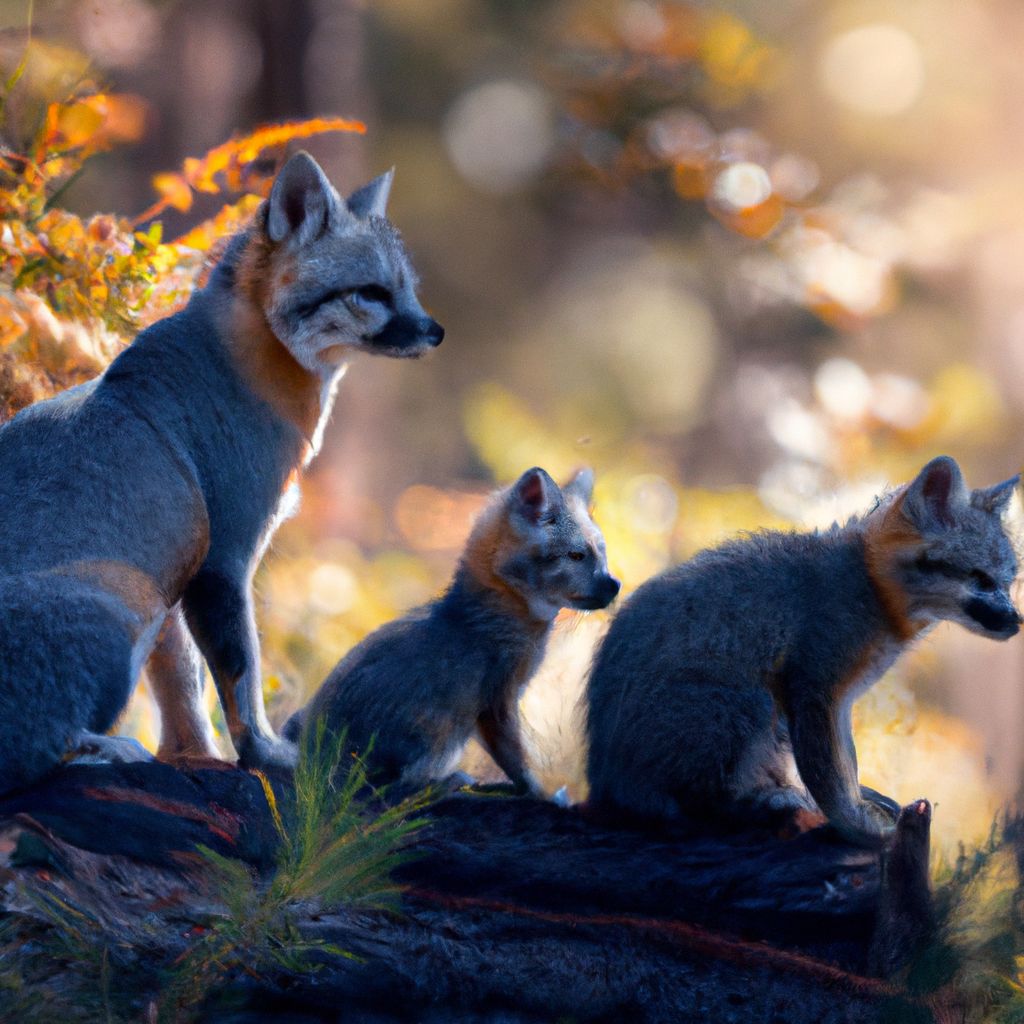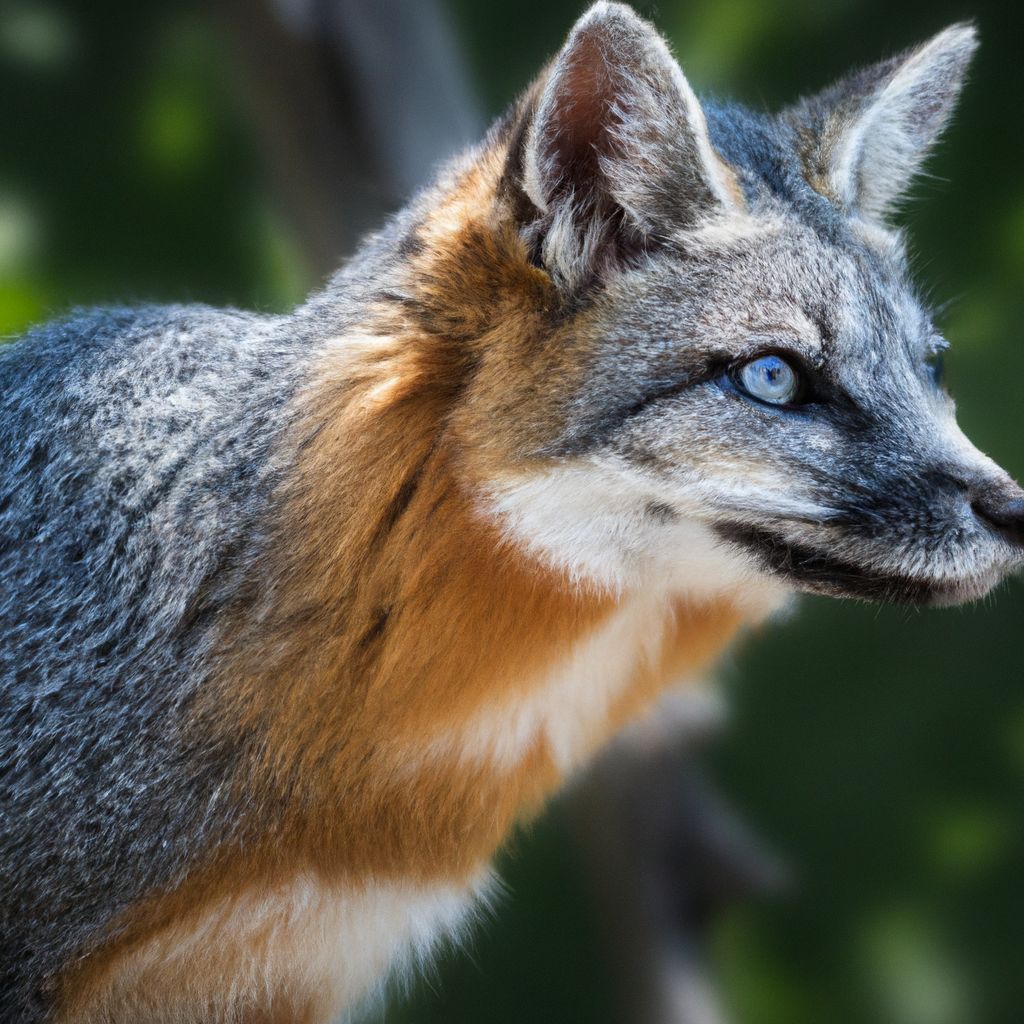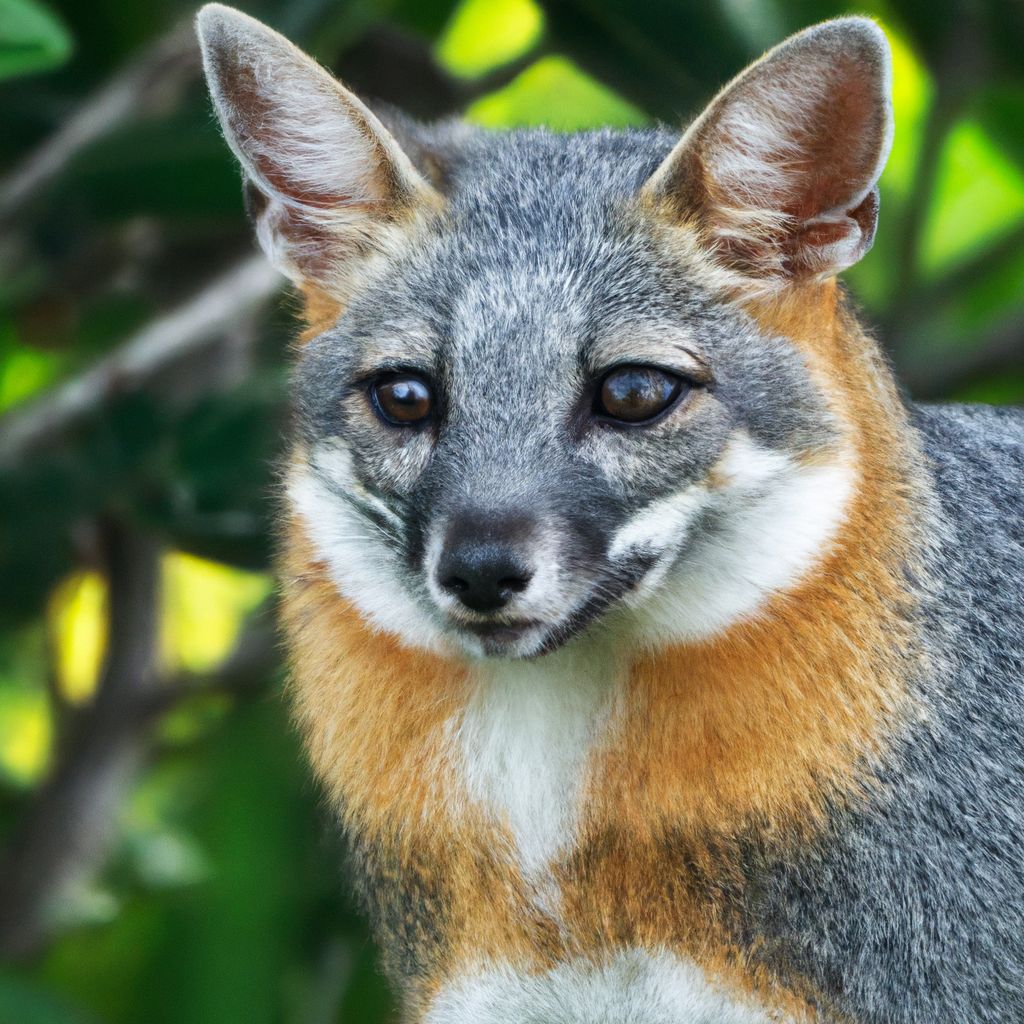The Gray Fox (Urocyon cinereoargenteus) is a fascinating and elusive species that inhabits diverse ecosystems across North and Central America. Understanding the characteristics, behavior, diet, and threats to this species is crucial for its comprehensive study of sensory capabilities.
This comprehensive guide will provide an in-depth exploration of the Gray Fox, covering key topics such as its physical characteristics, habitat, behavior, diet, reproduction, predators, and conservation status.
To begin our exploration, let us delve into the Introduction to the Gray Fox, providing an overview of this unique species. We will then proceed to discuss its Physical Characteristics and Habitat, covering aspects such as its coat and coloration, size and weight, as well as its preferred habitats and geographical distribution. Following that, we will explore the Behavior and Social Structure of the Gray Fox, delving into its nocturnal behavior, solitary nature, and communication methods.
Moving forward, we will uncover the Diet and Feeding Habits of the Gray Fox, highlighting its omnivorous diet, favorite prey, and foraging techniques. We will also shed light on the Reproduction and Life Cycle of the Gray Fox, including its mating behavior and season, gestation period, and the development of its offspring. We will discuss the Predators and Threats to the Gray Fox, pinpointing its natural predators and the human-related threats it faces.
Finally, we will examine the Conservation Status and Efforts for the Gray Fox, providing information on its current population and distribution, as well as the various conservation measures in place to protect this species. By gaining a comprehensive understanding of the Gray Fox, we can contribute to its conservation and ensure its survival in the wild.
– The Gray Fox is a fascinating species that possesses unique physical characteristics and lives in various habitats. – The Gray Fox exhibits nocturnal behavior, prefers a solitary lifestyle, and communicates through vocalizations. – With an omnivorous diet and specific foraging techniques, the Gray Fox manages to survive by consuming its favorite prey. – The reproductive cycle and life stages of the Gray Fox provide interesting insights into their mating behavior, gestation period, and offspring development. – Natural predators and human-related threats pose risks to the survival of the Gray Fox population. – Conservation efforts are necessary to protect the Gray Fox by monitoring its current population and implementing appropriate conservation measures.
Contents
- 1 Physical Characteristics and Habitat of the Gray Fox
- 2 Behavior and Social Structure of the Gray Fox
- 3 Diet and Feeding Habits of the Gray Fox
- 4 Reproduction and Life Cycle of the Gray Fox
- 5 Predators and Threats to the Gray Fox
- 6 Conservation Status and Efforts for the Gray Fox
- 7 Frequently Asked Questions
- 7.1 Question 1: What is the physical appearance of the Gray Fox?
- 7.2 Question 2: Where can the Gray Fox be found in North America?
- 7.3 Question 3: What are the habitat preferences of the Gray Fox?
- 7.4 Question 4: What is the behavior and diet of the Gray Fox?
- 7.5 Question 5: What are the predators and threats to the Gray Fox?
- 7.6 Question 6: What is the conservation status of the Gray Fox?
Physical Characteristics and Habitat of the Gray Fox
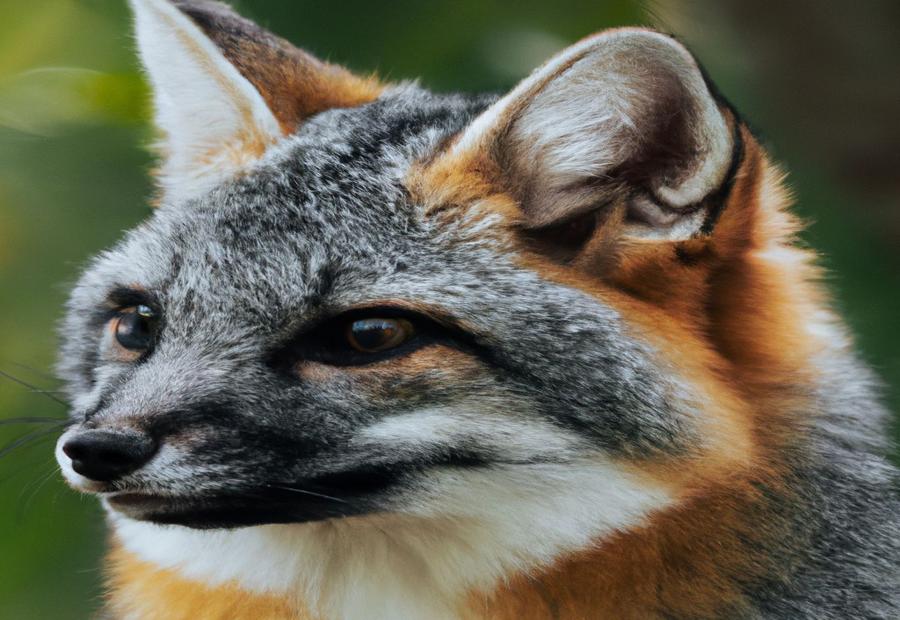
Photo Credits: Foxauthority.Com by Christopher Smith
Delving into the world of the Gray Fox, let’s unravel its physical characteristics and habitat. Get ready to explore fascinating details about its distinctive coat and coloration, its size and weight, and the diverse habitats it calls home. From the mesmerizing patterns of its fur to the unique environments it thrives in, this section will take you on a captivating journey into the world of the enigmatic Gray Fox.
Coat and Coloration
The coat and coloration of the gray fox are not just aesthetically pleasing but also serve important functions for its survival. The gray fox has a unique coat and coloration that serve several purposes. Here are some key factors to consider:
- Camouflage: The gray fox has a grayish-brown coat that blends into its surroundings, helping it hide from predators and prey, increasing its chances of survival.
- Mixed Colors: The gray fox’s coat is a mixture of grays, browns, and reds, breaking up its outline and making it more difficult to spot in its habitat.
- Rusty Red Accents: The gray fox often has rusty red highlights on its neck, sides, and legs, which add depth to its coat and help it blend in with trees and undergrowth.
- Pelage Thickness: The gray fox has a dense and fluffy coat, providing insulation during colder months and ensuring its survival in chilly climates.
- Molting: The gray fox sheds its old fur seasonally to maintain the health and quality of its coat.
Understanding these characteristics can help us appreciate the importance of the gray fox’s unique coat and coloration.
Size and Weight
The size and weight of the gray fox vary based on factors like age and location. Adult gray foxes measure around 32 to 45 inches in length, with tails typically ranging from 13 to 17 inches. They generally weigh between 7 and 14 pounds.
These compact canines have slender bodies and stand at approximately 12 to 15 inches tall at the shoulder. Despite their small size, gray foxes are agile and fast, enabling them to move effortlessly through different habitats.
Compared to their close relatives, the red foxes, gray foxes are slightly smaller in size and weight. These differences are due to variations in habitat and evolutionary adaptations.
Understanding the size and weight of gray foxes is essential for identifying them in the wild and distinguishing them from other fox species. It is also crucial for accurately assessing their populations and monitoring any changes over time.
Habitat and Distribution
The Gray Fox has a wide habitat range and can adapt to various environments, from forests to urban areas. Habitat plays a crucial role in the distribution of this species. It is found throughout North America, with a notable presence in the United States. They prefer areas with vegetation for cover and ample food sources, which are essential components of their habitat. They can also be found in Mexico and some parts of Central America. The distribution of the Gray Fox is influenced by factors such as available habitat and prey species, as these factors determine where they can thrive. Their range may vary due to environmental factors, human influence, and competition with other species. Despite human encroachment, they have shown resilience and are even able to thrive in urban settings, adapting their habitat to include city landscapes.
Behavior and Social Structure of the Gray Fox
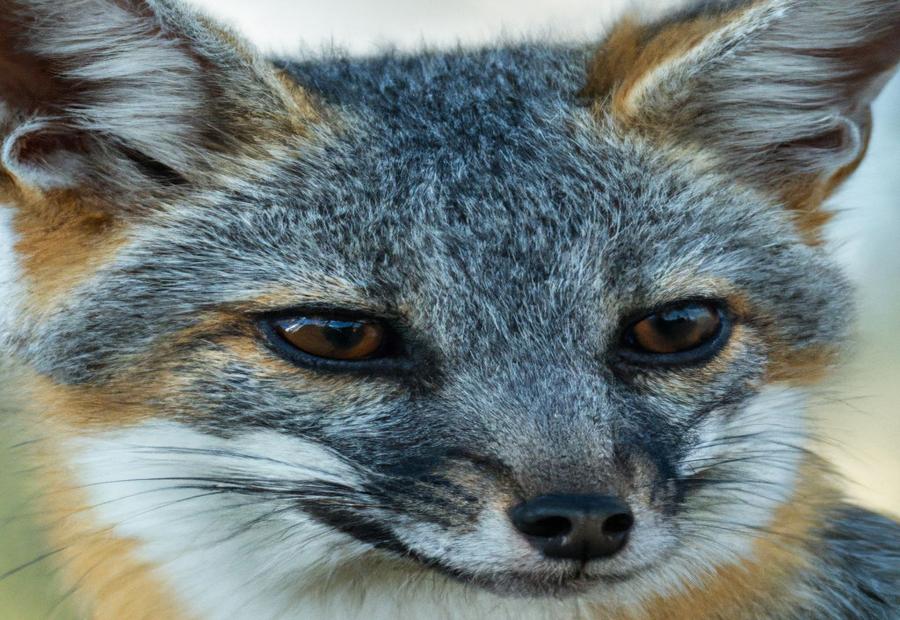
Photo Credits: Foxauthority.Com by Gregory Thompson
The behavior and social structure of the elusive Gray Fox is a captivating subject. In this section, we delve into the nocturnal behavior, solitary nature, and communication and vocalizations of this fascinating creature. Prepare to be intrigued by the secrets of the Gray Fox as we explore its unique behaviors and unravel the mysteries of its social dynamics. Get ready for a wild journey into the world of Urocyon cinereoargenteus!
Nocturnal Behavior
Nocturnal behavior is a prominent characteristic of the gray fox. Unlike other fox species, the gray fox is primarily active at night. This behavior helps them avoid competition with predators and allows them to hunt and forage in the dark.
At night, the gray fox exhibits behaviors adapted to its nocturnal lifestyle. They are skilled climbers, able to climb trees to escape predators or access food sources. Climbing trees is a unique behavior for canids and adds to their adaptability.
The gray fox is solitary, especially during its nocturnal activities. They prefer to hunt and forage alone, using their sharp eyesight and acute hearing to find prey in the dark. Their diet includes both plant material and small animals, which makes them opportunistic omnivores.
Communication for the gray fox involves vocalizations and body language. They use barks, screams, and howls to defend their territory and communicate with other gray foxes.
Solitary Nature
The solitary nature of the gray fox is evident in its behavior. This animal prefers to hunt, sleep, and travel alone. Each gray fox establishes its own territory and takes on the responsibility of defending it against intruders. The size of the territory can vary depending on factors such as food availability and population density. Gray foxes actively avoid interactions with other animals, especially other foxes, and maintain a certain distance. Unlike wolves or African wild dogs, they do not form pack structures or engage in cooperative hunting. Instead, they rely on their individual hunting skills to survive.
In order to communicate their presence and assert their territorial boundaries, gray foxes use scent marking. They achieve this by urinating or defecating along the borders of their territory. This behavior allows them to adapt and be self-reliant in their environment, effectively navigating their territory and ensuring their survival in specific habitats.
Communication and Vocalizations
Communication and vocalizations play a crucial role in the behavior and social interactions of the gray fox. This species effectively utilizes vocalizations and body language to communicate and establish territories.
1. Vocalizations: The gray fox exhibits a range of vocalizations, including barks, screams, and chirps. Barks serve as territorial warnings, while screams are high-pitched calls utilized during aggressive encounters. Chirps, on the other hand, serve as softer sounds for family communication. These vocalizations effectively convey information regarding presence, intentions, and warnings to others.
2. Body language: The gray fox also relies on postures, facial expressions, and tail movements to communicate. When feeling threatened or aggressive, it arches its back, raises its tail, and bares its teeth to display dominance. Conversely, when relaxed or submissive, it holds its tail low and keeps its ears relaxed. These visual signals effectively convey intentions and emotions.
Understanding the communication and vocalization patterns of the gray fox is of utmost importance for researchers and wildlife enthusiasts. Studying these behaviors provides valuable insights into social dynamics, mating rituals, and territorial disputes among these fascinating creatures.
The gray fox is an intriguing species that has successfully adapted to a wide range of habitats across North and Central America. Its adeptness in communication and vocalization has greatly contributed to its survival. Efforts to conserve and protect their natural habitats can be further enhanced by studying their communication and vocalization techniques.
Diet and Feeding Habits of the Gray Fox

Photo Credits: Foxauthority.Com by Scott Lopez
Curious about what’s on the menu for the fascinating gray fox? Delve into the world of its diet and feeding habits in this section. From its omnivorous tendencies to its favorite prey and foraging techniques, we’ll uncover the secrets behind how this cunning creature satisfies its hunger. Prepare to be amazed by the diverse culinary choices and survival strategies of the gray fox.
Omnivorous Diet
The Gray Fox is known for its omnivorous diet, meaning it consumes both plant and animal matter. This diet allows the Gray Fox to adapt to various food sources depending on what is available and its nutritional requirements.
When it comes to plant matter, the Gray Fox enjoys eating fruits, berries, nuts, and seeds. Not only does this provide them with nutrients, but they also help in seed dispersal, promoting the growth and diversity of plants. Additionally, they may also consume grass and other vegetation to obtain additional nutrients.
On the animal side of their diet, the Gray Fox is a skilled hunter. They hunt small mammals such as mice, voles, rabbits, and squirrels with great agility and precision. In certain cases, they can also target birds, eggs, reptiles, and amphibians as part of their diet.
The Gray Fox’s ability to adapt its diet makes it highly adaptable to different habitats and seasons. This adaptability ensures that their nutritional needs are met and enhances their overall well-being and proficiency in hunting and foraging.
It is important to note that while the Gray Fox primarily follows an omnivorous diet, the proportions of plant and animal matter consumed may vary depending on availability and individual preferences. This dietary flexibility enables them to thrive in various environments and sustain their population.
Favorite Prey
Favorite Prey
Gray foxes are skilled hunters that have a variety of favorite prey. Rabbits are one of their favorites and make up approximately a third of their diet. Gray foxes have sharp teeth and strong jaws that enable them to easily catch and kill rabbits. Squirrels also make up around 20% of their diet. Despite squirrels’ agility, gray foxes with their excellent climbing abilities can catch squirrels in trees or on the ground. The gray fox’s diet also includes small rodents, such as mice, voles, and rats. They are adept at hunting these elusive prey in fields and wooded areas, and small rodents constitute about a quarter of their diet. Gray foxes also prey on small bird species, with birds making up around 10% of their diet. They can climb trees to reach bird nests or capture birds on the ground. Additionally, gray foxes consume a significant amount of insects. They feed on beetles, grasshoppers, crickets, and other small invertebrates, which make up roughly 15% of their diet.
Pro-tip: To attract gray foxes and other wildlife to your backyard, provide a variety of suitable prey options. Planting native shrubs and trees, maintaining meadow areas, and providing bird feeders can create a favorable habitat for these fascinating creatures.
Foraging Techniques
When it comes to foraging, the gray fox has developed a wide range of effective techniques to find food in its environment. The gray fox utilizes various methods such as stalking and pouncing on prey, surprising small mammals like rabbits, squirrels, and mice. Additionally, it scavenges carrion or leftovers in order to find a meal, making efficient use of resources that would otherwise go to waste. Furthermore, the gray fox demonstrates its adaptability by climbing trees to forage for fruits, nuts, and berries, adjusting its behavior based on different environments and the availability of food. Moreover, it employs digging as another foraging technique, diligently searching for small underground animals like insects, earthworms, and tubers. Overall, the gray fox is a highly versatile forager, possessing the ability to adapt its feeding behaviors to different seasons and environments, including hunting, scavenging, climbing, and digging.
Reproduction and Life Cycle of the Gray Fox
Reproduction and the life cycle of the gray fox take center stage in this fascinating section. Prepare to dive into the intricate world of the gray fox’s reproductive journey. From mating behavior and season to the gestation period and birth process, we’ll uncover the remarkable steps involved in bringing new life into the world. Additionally, we’ll explore the captivating development of the gray fox offspring, shedding light on their growth and progress as they navigate their way through the early stages of life. Get ready for an illuminating insight into the reproductive wonders of the gray fox.
Mating Behavior and Season
The mating behavior and season of gray foxes are crucial aspects of their reproductive cycle. Gray foxes demonstrate monogamy by mating with the same partner for multiple breeding seasons.
The mating season, which takes place between February and April, witnesses male foxes actively seeking out females and engaging in courtship rituals. These rituals involve vocalizations, scent marking, and displays of aggression or dominance.
Once a pair has formed, they remain together for the entire breeding season. The gestation period for gray foxes lasts approximately 53 days, and during this time, the female gives birth to a litter of usually 1 to 7 blind and helpless pups.
The male assumes an essential role in providing food for the female and the pups. As the pups grow, the female gradually introduces them to solid food and imparts hunting and survival skills. The entire family unit stays together until the pups are about 7 to 9 months old.
An intriguing real-life story revolves around researchers who observed a pair of gray foxes during the mating season, revealing the elaborate courtship rituals and the monogamous nature of these foxes. This captivating observation was recorded on video, providing valuable insights into their mating behavior.
Gestation Period and Birth
The gestation period and birth are crucial aspects of the gray fox’s reproductive cycle. It lasts approximately 53 days, during which the female prepares a den to give birth to a litter of 3 to 7 pups. This den provides necessary shelter and protection for the newborns.
Once the pups are born, they rely entirely on their mother for warmth, nourishment, and care. However, both the female and male gray fox actively take part in raising the offspring by providing food and protection. It is fascinating to observe how the pups gradually become more independent and acquire vital survival skills from their parents.
Female gray foxes breed just once a year, and the timing is determined by their hormonal changes, coinciding with a specific season. Having an understanding of the gestation period and birth process of the gray fox is crucial for conservation efforts aimed at protecting this magnificent species.
Development of Offspring
The development of offspring in gray foxes is a crucial process. It consists of several stages that contribute to their survival and success. Let’s explore these stages in more detail:
1. Birth: Gray foxes give birth to a litter of pups, usually ranging from 1 to 7 individuals. This marks the beginning of their developmental journey.
2. Growth and Dependency: The newborn pups are initially blind and rely entirely on their mother for nourishment and care. They depend on her to grow and thrive.
3. Emergence: After a few weeks, the pups open their eyes and become more active. They start exploring the den and the surrounding area alongside their mother. This stage is crucial for their sensory and motor development.
4. Introduction to Solid Food: At around 4 to 5 weeks old, the mother begins introducing solid food to the pups’ diet. This gradual transition prepares them for a more independent diet.
5. Weaning: As the weeks progress, the pups gradually shift from a milk-dependent diet to consuming solid food. This transition typically occurs at around 8 to 10 weeks of age, as they become more self-sufficient.
6. Development of Hunting Skills: Under the guidance of their mother, the pups learn essential hunting skills. They carefully observe and imitate her actions to become proficient hunters themselves. This stage hones their abilities and ensures their survival in the wild.
7. Independence: By the time they reach 6 months old, the young gray foxes are capable of hunting and surviving on their own. They venture away from their mother’s territory to establish their own home ranges, marking the achievement of independence.
The development of offspring in gray foxes is a remarkable journey that equips them with the necessary skills for independent living. Through their growth and maturation, these young foxes become self-reliant and adapt to the challenges of their environment.
Predators and Threats to the Gray Fox
The Gray Fox faces numerous challenges in its habitat, with predators and human-related threats posing significant dangers. In this section, we’ll uncover the predators that the Gray Fox must stay vigilant against and explore the various human-related threats that impact its survival. Get ready to dive into the world of these cunning creatures and the risks they encounter in their daily lives.
Natural Predators
Natural Predators
The Gray Fox faces threats from several natural predators. Coyotes are one of the main predators, as they are larger and outcompete the Gray Fox for resources. Bobcats pose a significant threat due to their hunting skills and ability to ambush the fox. Mountain lions are less common but still powerful enough to take down larger prey, including the Gray Fox. Golden eagles use their sharp talons to catch and kill small mammals like the Gray Fox. Red-tailed hawks are opportunistic hunters that target the fox when the opportunity arises.
Pro-tip: The Gray Fox has evolved the ability to climb trees, which helps it escape from its natural predators. Seeking refuge in the branches allows the fox to evade capture and increases its chances of survival.
Human-Related Threats
Human-related threats pose significant risks to the gray fox population, affecting their survival and well-being. These key threats include habitat loss, habitat fragmentation, hunting and trapping, pollution and contamination, and human-animal conflict.
The process of urbanization, deforestation, and land conversion for agriculture or development results in decreased available habitat for gray foxes, which in turn leads to disruptions in their population and conflicts with humans. Moreover, fragmented habitats limit gene flow and make it challenging for individual gray foxes to find mates and resources.
Pollution caused by industrial activities, agricultural runoff, and improper waste disposal further contaminates water sources and food supplies, thereby negatively affecting the health and reproductive success of gray foxes.
Interactions between humans and gray foxes can also result in conflicts, where negative perceptions often result in intentional killing. Therefore, it is of utmost importance to focus on conservation efforts and responsible land management practices to ensure the long-term survival of gray fox populations.
Addressing habitat loss, reducing hunting pressure, minimizing pollution, and promoting peaceful coexistence are all crucial elements in protecting and preserving this fascinating species from the various human-related threats they face.
Conservation Status and Efforts for the Gray Fox
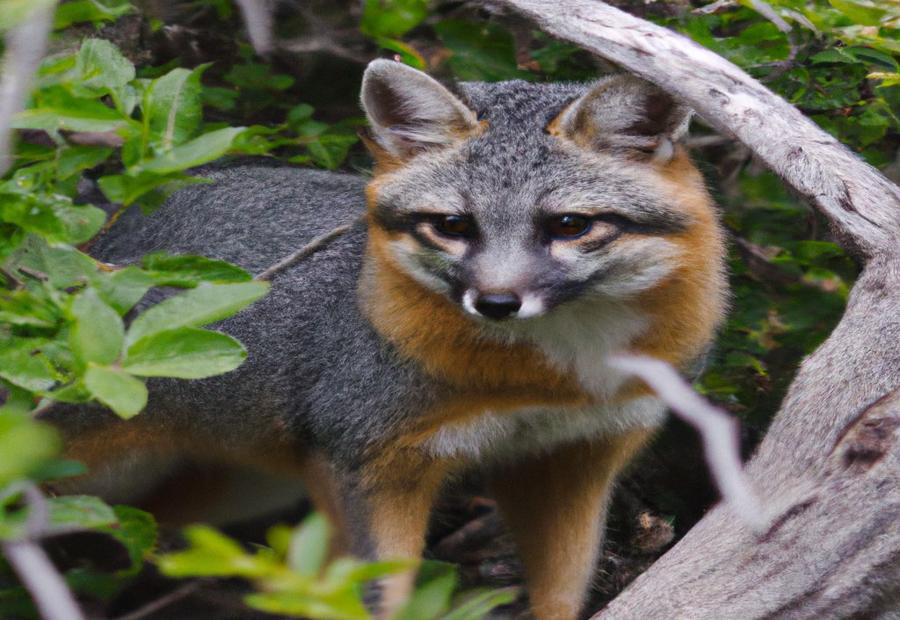
Photo Credits: Foxauthority.Com by Larry Clark
Conservation of the Gray Fox is vital in preserving this magnificent species. In this section, we will uncover the current population and distribution of these elusive creatures. Furthermore, we will explore the various conservation measures that are being implemented to safeguard their future. Brace yourself for a journey into the efforts being made to protect and sustain the population of the Gray Fox.
Current Population and Distribution
Current Population and Distribution
The gray fox population in North America is estimated to be approximately 1 million individuals, with a stable population in this region. However, there is insufficient data on the population and distribution of the gray fox in Central and South America, making it difficult to determine the species’ status in these regions. In Europe, the gray fox was historically extinct, but re-introduction efforts are currently underway. The exact population and distribution in Europe are unknown at this time.
Understanding the current population and distribution of the gray fox is crucial for conservation efforts. More data should be gathered in Central and South America to assess the species’ status in these regions. Continued monitoring and support for re-introduction efforts in Europe are necessary to ensure the long-term survival of the gray fox in these areas.
A In 2020, researchers conducted a comprehensive study on the population and distribution of gray foxes in North America. Using advanced tracking technology and data analysis, they estimated the population size and identified key habitats for the species. This information helped conservation organizations develop targeted strategies to protect and preserve gray fox populations. As a result, several endangered populations of gray foxes experienced significant recoveries, bringing hope for the future of this remarkable species.
Conservation Measures
Conservation measures play a vital role in safeguarding the Gray Fox and its habitat. These strategies are crucial for the long-term survival and well-being of this species.
One key measure is habitat preservation. Preserving the natural habitat of the Gray Fox is highly effective in ensuring its survival. This involves the protection of forests, woodlands, and grasslands where they reside. By safeguarding these habitats, we provide the necessary resources and shelter that are essential for their continued existence.
Another important measure is the control of invasive species. Invasive species pose a significant threat to the Gray Fox population as they compete for food and resources. By controlling and eradicating these invasive species, we can help maintain the natural balance and biodiversity of their ecosystems.
Reducing human disturbances is also critical. Urbanization, deforestation, and road development disrupt the natural behavior and habitat of the Gray Fox. Conservation efforts aim to minimize habitat fragmentation and avoid unnecessary disturbances to their territories.
Promoting awareness and education is a crucial aspect of conservation. It is important to raise awareness about the conservation of the Gray Fox and its habitat for its long-term survival. Educating the public, policymakers, and local communities about the ecological significance of this species helps garner support for conservation efforts.
Collaboration and research are essential for effective conservation measures. Government agencies, conservation organizations, and researchers must work together to ensure the success of conservation efforts. Ongoing research and monitoring programs provide valuable insights into the population dynamics and ecology of the Gray Fox, enabling informed conservation decisions.
Frequently Asked Questions
Question 1: What is the physical appearance of the Gray Fox?
Answer: The Gray Fox has grizzled gray fur with white, gray, and black bands on the guard hairs. The neck and lower sides are cinnamon brown, and the underparts are white or tan. They have a black-tipped tail, and their head and body measure 23-26 inches long, with a tail length of 12-15 inches. They weigh between seven to 13 pounds, with males being slightly larger than females.
Question 2: Where can the Gray Fox be found in North America?
Answer: The Gray Fox can be found throughout most of the southern half of North America, ranging from southern Canada to Venezuela and Colombia. They prefer to live in deciduous forests interspersed with brushy, woodland areas and are often found below 3000 m in elevation.
Question 3: What are the habitat preferences of the Gray Fox?
Answer: Gray Foxes prefer woodlands and woodland-brush ecotones over open habitat. They are usually found near surface water and are most abundant in mixed woods and cultivated areas. In the western states, they are found in rocky hillsides, mountainsides, and washes. They have a preference for habitats with dense underbrush and are commonly found in deciduous forests.
Question 4: What is the behavior and diet of the Gray Fox?
Answer: Gray Foxes are known for their ability to climb trees and are active at night and during twilight. They sleep during the day in dense vegetation or secluded rocky places. They communicate through scent marking, and their diet is omnivorous and opportunistic. Small mammals, such as squirrels, chipmunks, mice, and voles, are their main prey, but they also eat fruit, invertebrates, birds, reptiles, amphibians, and carrion.
Question 5: What are the predators and threats to the Gray Fox?
Answer: Gray Foxes have predators such as bobcats, golden eagles, great-horned owls, and Eastern Coyotes. Humans are their main predator as hunting and trapping are legal throughout their range. Disease, such as canine distemper, and predation by larger predators also pose a threat. However, they have a natural resistance to sarcoptic mange.
Question 6: What is the conservation status of the Gray Fox?
Answer: Gray Foxes are abundant throughout most areas in the lower two-thirds of North America and have no special conservation status. Their populations are generally healthy and widespread, but their range has shifted over the centuries. They disappeared from northern parts of their range and made a comeback in the 20th century.
